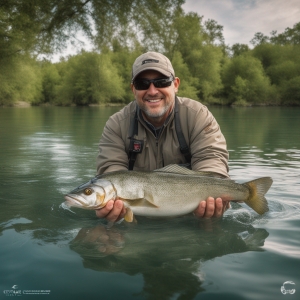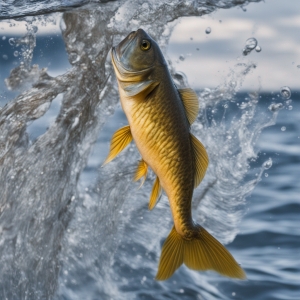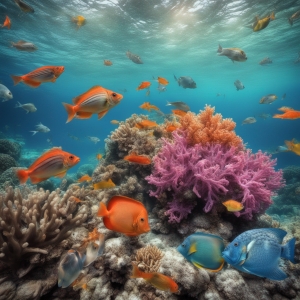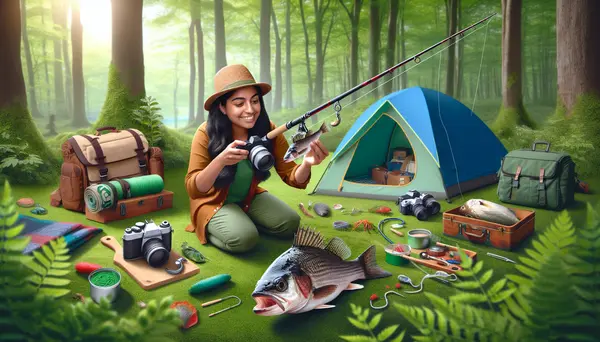Table of Contents:
Introduction to Fish Photography
There's an ancient saying that goes, "a picture is worth a thousands words" and when it comes to fishing, this couldn't be truer. Immortalizing your catch through the lens of a camera enriches the fishing experience and provides a thrilling way to share your adventures with friends and family. But not all fish photos are created equal. The art of fish photography demands certain skills and consideration. By understanding the basics and applying a few helpful tricks, you can turn simple snapshots into awe-inspiring depictions of your angling achievements. In this guide, I'll share some insights on capturing those unmissable moments and making every fish photograph worth more than a thousand words.
Understanding Your Equipment
Fishing and photography are both about patience, preparation and using the right tools. For fish photography, your most crucial tools are your camera and lighting. Understanding how to utilize them can make all the difference in capturing high-quality images. Even if you're using nothing more than your smartphone, knowing a few tricks about angles, focus, and brightness will dramatically improve your photo quality.
Whether your camera is a high-end DSLR or a simple point-and-shoot, learning about its features and understanding how to navigate through them can significantly improve your snaps. Things like shutter speed, aperture, and ISO can play essential roles in how your images turn out. Getting familiar with these will give you more freedom to control the final look of your photos.
Then, there's the lighting. Simply put, good lighting is key to a great photograph. Depending on the time of day, the natural light can either be your best friend or worst enemy. Knowing how to handle this can greatly influence the clarity and impact of your images. Remember, it's always best to have the light source behind the camera.
Learning to use your equipment correctly might require time and patience, but it's worth it. With some practice, you'll be able to avoid common mistakes and capture perfect fish photos every time.
Fish Photography: Advantages and Disadvantages
| Pro | Con |
|---|---|
| Perfect for capturing memorable moments | Potentially harmful for the fish if not done properly |
| An unusual and interesting subject | Requires a lot of patience and skill |
| A great way to share your passion for fishing | May require expensive equipment |
| Can be a relaxing and calming hobby | Weather conditions and lighting can affect the quality of the photos |
Choosing Your Location

Aside from mastering your equipment, choosing the right location is fundamental in capturing stunning fish photos. The backdrop of your shot can significantly influence the outcome of your photo. A chaotic or dull background can make your image unappealing, while an organized and interesting one can enhance the focus on your hero - the fish.
Firstly, avoid overly cluttered or distracting backgrounds. Ensure there's a proper contrast between the color of the fish and the surroundings to let your catch stand out. Aim for natural backgrounds like water, sky, or green foliage to maintain an authentic fishing vibe. Capturing the landscape where you're fishing can add a nice touch, narrating a fuller story of your fishing adventure. Skies reflecting in tranquil water, a boat softly bobbing nearby, or towering forested banks, can all add fantastic dimensions to your photo.
Ultimately, the best location is the one that frames your catch in the most flattering way while showcasing the beauty of nature. Being mindful of this when positioning your shot will result in richer and more captivating fish images. Mastering the Lighting
Proper lighting can make your fish stand out and truly sparkle in your photos, giving them a lifelike and vibrant presence. The use of natural light is the best way to achieve this and enhancing your understanding of lighting conditions can significantly impact the outcome of a photo.
On cloudy days, the overcast sky acts like a natural diffuser, softening shadows and reducing glare. This kind of soft, even light is ideal for photographing fish as it brings out the natural color and detail of your catch. However, avoid shooting in rain or fog as it can obstruct clarity and reduce the overall sharpness of the image.
Direct sunlight can often result in harsh lighting conditions, with strong shadows and overexposed highlights. But it doesn't mean that you can't shoot in sunlight. In fact, you can harness the intensity of direct sunlight to create dramatic and eye-catching images. The rule of thumb here is to have the sun behind the photographer so that the subject is well lit. With the sun at your back, your fish will be awash with sunlight, revealing all the iridescent details of its scales.
Sometimes you may find yourself in situations where neither sunlight nor shade can provide adequate lighting. It could be at dawn, dusk, or under the thick canopy of trees. In such scenarios, the use of artificial lights, like the camera flash, can come to your rescue. A well-balanced use of flash can add a necessary pop of light to your subject without making it appear artificial or washed out.
Understanding and playing with lighting is a crucial aspect of photography. As you experiment and learn, you'll find that mastering the lighting can truly elevate your fish photography to the next level.
Getting the Right Angle

The angle at which you capture your fish can make a significant difference to your photographs. It influences the perception of the fish's size, highlights its features, and adds depth to the images. Here are some tips to help you find the best angle for your fish photography.
Eye-Level Shots: By getting down to the level of the fish, you can capture interesting and engaging photographs. It gives the viewer a sense of being right there in the action. However, be careful not to overshadow the fish or create unwanted reflections in the water.
Overhead Shots: These shots are ideal for showcasing the size and scale of the fish. They also enable you to capture a clear view of the fish's body and the surrounding area. However, you need to ensure that the sunlight doesn't create a glare on the fish or the water.
Side Shots: The side angle is particularly effective for showcasing the color and texture of the fish. It also works well when you want to include the landscape in the background. Make sure the focus is on the fish, though, and not on the background.
Underwater Shots: If you're feeling adventurous and have the right equipment, underwater shots can create some truly stunning images. They allow for a unique perspective and can make for some dramatic shots. Remember to adjust your camera settings for underwater photography.
Experimenting with various angles will help you find what works best in different circumstances. It will not only vary your photography style but will also add a unique perspective to each photograph, bringing them to life. Finding the right angle can take some practice and patience, but the outcome is worth the effort.
Preserving the Natural Look
Arguably, one of the biggest thrills in fish photography is capturing a photo that reflects the authentic beauty of the catch in its natural environment. Emphasizing the natural look depends on a few key techniques. Let's explore how you can enhance this aspect to share eye-catching shots of your fishing moments.
Firstly, the position of the fish is crucial. Menacing upwards angles or head-on shots can distort the natural shape and size of the fish. A side-on view is usually more aesthetically pleasing, as it accurately represents the proportions of the fish and showcases its colors and patterns. Whenever possible, photograph the fish while it's in the water or just above it. This not only adds to the authenticity of the fishing experience but also reflects the fish in its native surroundings.
Secondly, treat your catch with care. Harsh handling can damage the fish and rob it of its natural sparkle. Always make sure your hands are wet before touching a fish, to avoid removing the protective slime on its scales. Keep your hands clean and free of sunblock or bug spray, as these can have harmful effects on the fish and may also be captured in the photograph.
Lastly, aim to capture the fish's most distinct features – vivid colors, unique shapes, and intricate patterns. Each species of fish possesses varying degrees of these features, and capturing them could make the difference between an ordinary photo and an extraordinary one. Remember – the natural beauty of the fish is the star of the photo. The more you emphasize that, the more visually arresting your image will be.
Indeed, capturing the fish’s natural look isn't just about snapping a quick photo. It demands care, respect for the fish, and some technical know-how. The reward is a stunning photograph that paints a compelling picture of your fishing adventure and respects the beauty of aquatic life.
Ensuring Fish Safety

It's important to remember that while photography can be an exciting aspect of fishing, the safety and well-being of your catch are paramount. Fish are delicate creatures and should be handled with care to minimize stress. When posing with your catch, make sure not to squeeze or grip too tightly as this can harm the fish.
Try to keep the fish out of water only long enough for your shot and then promptly return it. Avoid keeping it on rough or dry surfaces as this can damage its protective slimy layer. If possible, wet your hands before touching the fish; this can help minimize the amount of protective slime that gets rubbed off.
If you're going for a 'fish in the water' shot, be gentle and mindful. Let the fish recover and gather strength before releasing it back into the water. These practices are not just about ethical fishing; they also help to ensure the fish looks its best in your photos, displaying vibrant colours and beautiful patterns.
Observing these safety measures can help preserve fish populations and ensure future fishing adventures. After all, every angler has a responsibility to contribute to the sustainability of the sport.
Editing Your Fish Photos
After capturing the photo, the next step is editing. This is where you can truly transform a good photo into a great one. Technological advancements have given us handy editing apps that can significantly enhance the quality of our photos. Even simple tweaks in color, contrast, and sharpness can make your fish stand out more vividly. But remember not to get carried away. The goal is to enhance the features of the photo, not to alter them completely.
Begin with adjusting the brightness and contrast. A good balance of both can highlight the unique features of your fish and backdrop. Next, consider improving the sharpness of the image. This brings out the tiny details that can sometimes be overlooked, such as the intricate patterns on the fish's scales or the reflection of the light on the water.
Color correction can also make a significant difference in your photo. There are three aspects to look at here: hue, saturation, and vibrance. Hue alters the overall color theme, saturation adjusts the intensity of the colors, and vibrance increases the intensity of the more muted colors. Adjusting these can help the colors in your photo appear more vibrant and true-to-life.
Lastly, consider cropping the image, if necessary, to remove any unwanted elements and create a more focused and appealing composition. Be mindful not to compromise on the quality of the main subject, your fish, in this process.
With many easy-to-use photo editing tools available today, you don't have to be a professional to make your photos look remarkable. Experimenting with the different settings and features will allow you to enhance your photos in ways you might not have imagined and truly get your fish to shine in the picture.
Sharing Your Fishing Moments
Once you've mastered capturing inspiring fish photos, the next step is sharing them with the world. Everyone has a unique perspective, and your fishing moments tell your individual fishing story. However, it's not just a matter of posting images online. There's an art to presenting these moments that can make them truly remarkable.
The first thing to remember is to provide some context. A good fish photo is not just about the catch, but also about the experience. Include some details about the trip: the location, any challenges overcome, the fishing method used, or the story behind the catch. This paints a vibrant picture and allows others to feel a part of your journey.
Always aim to maintain variety in your shared images. This not only keeps your content fresh but also offers a broader glimpse into your fishing world. Mix fish shots with scenic surroundings, close-ups on your gear, candid moments, or even the occasional 'one that got away' stories.
While sharing fishing moments, it's also important to remember to promote responsible angling. Share your practices about catch & release, handling fish with care and respecting fishing regulations. It educates others and reinforces the importance of sustainable fishing.
Lastly, engage with your audience. Respond to comments, take part in discussions, share tips and ask questions. Social sharing is as much about community as it is about showcasing your experiences. Your shared adventures can inspire someone else to take up the rod and start their own fishing journey.
Sharing your fishing moments allows you to relive your experiences and celebrate your achievements with others. Done effectively, it can encourage, inspire, and draw more people into the wonderful world of fishing.
Conclusion
There's no denying that a well-shot fish photo can be a stunning representation of an angler's efforts. It not only chronicles the size and beauty of your catch but the experience itself - something that you can look back upon and reminisce over. Achieving such images consistently may seem challenging initially but, with an understanding of your equipment, attention to the right location and lighting, plus practice, it becomes a rewarding endeavor.
Photography, much like fishing, is an art that strengthens with time and experience. So, don’t get disheartened if your first few snaps don’t turn out as expected. Remember, every click of the shutter brings you one step closer to capturing that perfect fishing moment. In this digital age, where sharing and celebrating is part of the online culture, effective fish photography allows you to share your angling accomplishments with the world, creating not just memories but stories that inspire others and showcase the wonders of angling.
Frequently Asked Questions about Fish Photography
What equipment is needed for fish photography?
A quality waterproof camera or housing, a polarizing filter to minimize water glare, and possibly a macro lens for close-ups are essential for fish photography.
How should I position the fish for a photo?
The best position for photographing a fish is to hold it horizontally, with a firm yet gentle grip, allowing its natural colours to shine.
What lighting is best for fish photography?
Natural, diffused light works best as harsh light can reflect off the fish and cast shadows, washing out detail and colour.
How can I capture a crisp, clear photo of a fish?
Focus on the eye of the fish, as our eyes are naturally drawn there. Using a fast shutter speed can also help freeze the motion and produce a clear shot.
What are some good tips for ethical fish photography?
Minimise the time a fish spends out of water, wet your hands before handling it and handle fish as little as possible. These are some ethical practices for fish photography.







